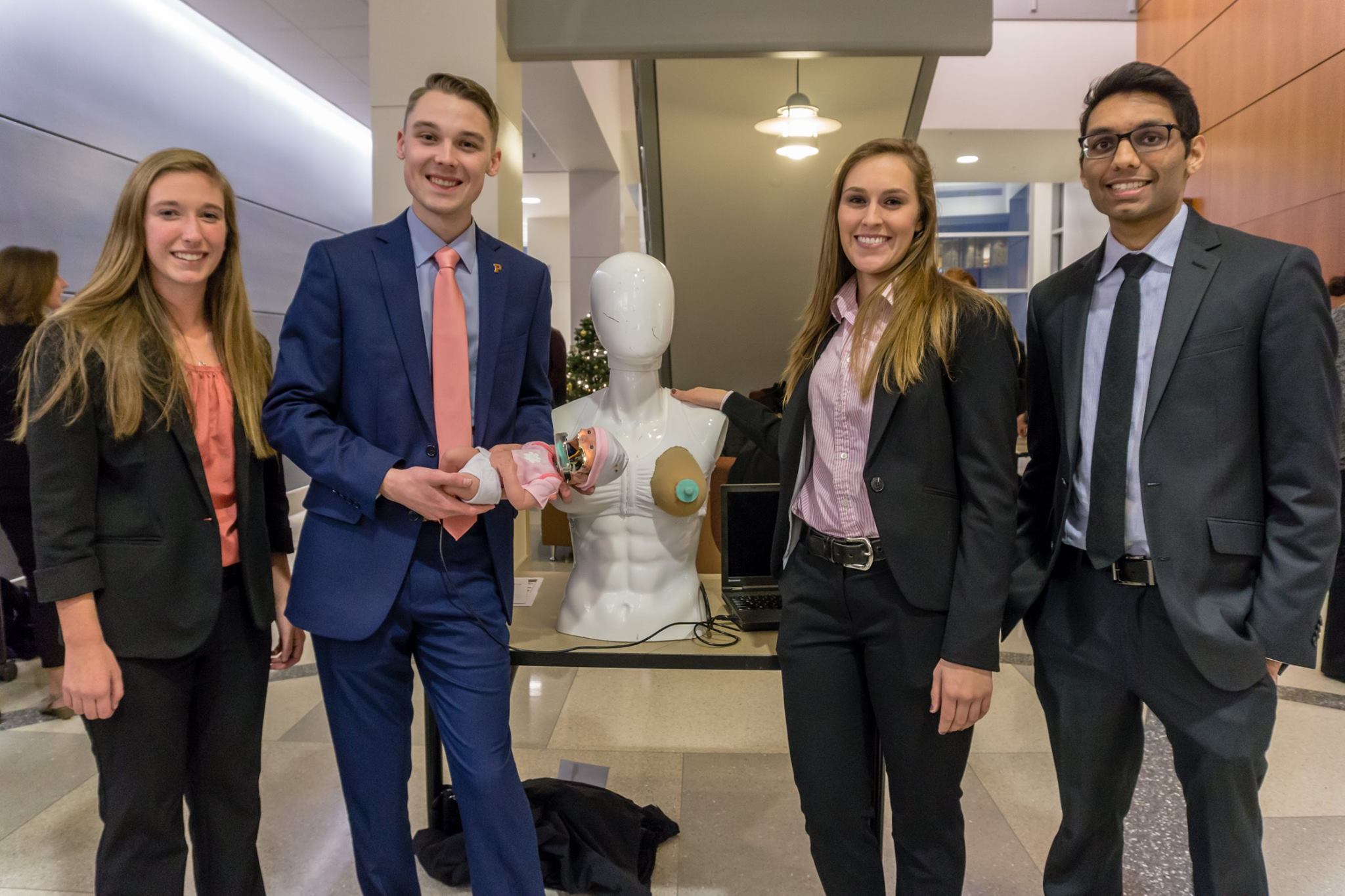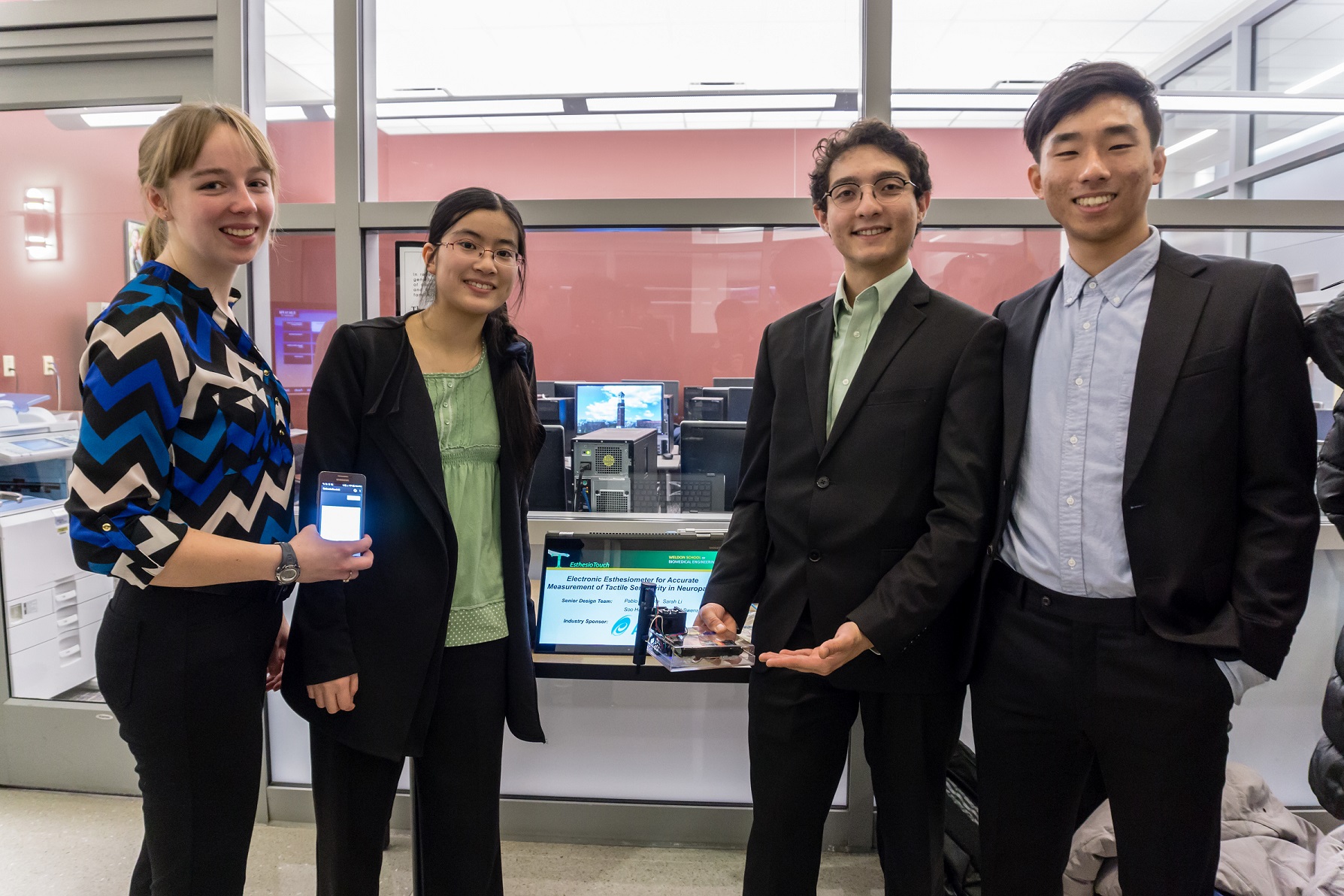Diversity in mentors, sponsors, and projects enrich senior design program

Collaborations and partnerships are vital to the Purdue University Weldon School of Biomedical Engineering senior design program. Partners contribute by providing a variety of clinically-relevant project ideas, clinical or industry mentoring of multidisciplinary teams, and material support and sponsorship.
“There is a large diversity of projects in our senior design program,” said Asem Aboelzahab, laboratory and assessment coordinator for the Weldon School. “The diversity in our faculty areas of expertise and among specializations of mentors and sponsors helps offer our students training in multiple skills and techniques, as well as access to various systems and equipment. This diversity and access is crucial to the success of our senior design course.”
The variety gives rise to a welcome environment for mentors and sponsors and the challenges they bring, which, in turn, gives students flexibility in the projects they choose and a greater chance of developing a project that is in line with their career ambitions.
Clinician identifies need for breastfeeding teaching tool
In her 42-year nursing career, Tina Babbitt, manager of the Breastfeeding Center at the Indiana University Health Methodist Hospital in Indianapolis, Indiana, and a board certified lactation consultant, has observed many new mothers struggling with breastfeeding. She is responsible for infant feeding education for nursing staff, and had an idea for a simulator that would help train nurses how to teach new mothers to breastfeed.
“I am a passionate fan of simulation methodology, and I felt strongly that having a breastfeeding simulator would be beneficial,” said Babbitt. “But, one does not exist! The concept stayed with me for several years, and I couldn’t let it go.”
She brought the concept to the Weldon School and was paired with a senior design team comprising seniors Alexandria Sacopulos, Jennifer Ray, Daniel Romary, and Neal Patel, who took the idea and ran with it.
“I hung up the phone after my very first call with the students, inspired,” said Babbitt. “They were professional, intelligent, and astonishing as to how much they got it–why this was important.”
When an idea comes from a stakeholder, it’s much more meaningful.
“Tina provided the team with a well-defined scope of exactly what’s needed and her perspective on certain aspects of medical training and diagnosis,” said Aboelzahab. “Those insights are critical.”
Students find it helpful to work with someone in the field who is familiar with the need.
“It was great to be able to design something and then take it to her and say, ‘What do you think? What needs to be changed?’” said Romary. “She’d say, ‘This isn’t quite right.’ Or, ‘Here’s how the process works.’ She was helpful in explaining the essential steps in the process and all of the little details that needed to be incorporated into the design.”
Babbitt was impressed with the team’s synergy and skill set. “They asked very pertinent questions, had a resilience and determination to overcome any obstacle that arose, and there were some,” recalled Babbitt.
By the end of the semester, the team had developed a working prototype, which they coined “Martina,” in honor of Babbitt.
“In December at their presentation, as they shared their final product, I experienced a sense of pride,” said Babbitt. “I played a small role in the actual hands-on creation, but the concept was now tangible, and it worked like a champ. This mentor experience is one of the highlights of my career.”
The team filed a disclosure with the Purdue Office of Technology Commercialization, and they are evaluating whether or not it’s a patentable device.
Learn more about the breastfeeding simulation system on the Weldon School Senior Design Projects page.

Industry explores device to measure tactile sensitivity
Sometimes a senior design project begins as an idea that is not within the realm of a company’s portfolio, but is one in which the company has an interest in exploring for its potential.
This was the case with a concept brought to senior design by AxoGen, Inc., a human tissue company based in Alachua, Florida, that makes products to remedy peripheral nerve damage.
“The opportunity that Purdue Weldon School of Biomedical Engineering offers to companies like AxoGen is to have a dedicated team of focused personnel to work on issues that are not currently a high priority for the company,” said Brian Romot, a product development engineer at AxoGen.
The company was interested in a diagnostic tool that measures tactile sensitivity and tasked the senior design team comprising Rachael Swenson, Sarah Li, Soo Han Soon, and Pablo Argote with coming up with a proof-of-concept device.
“The team proved to be independently capable of adapting to challenges we provided,” said Romot, one of the mentors for the senior design team. “In our discussions they were always surprising with the progress they were making every couple of weeks. They also looked deeper into the clinical goal for the product and came back with insightful comments on improvements or new options.”
Romot emphasized that the most important factors contributing to the success of a collaboration is setting clear goals from the outset and staying in constant communication so that expectations on both sides are met.
“Being able to bounce ideas off of Brian—this was the vision for this project, this is what we know, it needs to be able to do this—it helped us break down some of the requirements for what the device would be.” said Swenson. “Being able to talk to somebody who has an engineering background is very helpful because they understand what questions we are asking and why we need this information.”
The device they developed provides a consistent and data-driven method of evaluating tactile sensitivity thresholds. Although not yet a patentable product, Romot said that with the concept proved, there is a chance that work could go forward to move the project to a more finished design.
“It was wonderful to see what a group of students could accomplish in a short period,” said Romot. “This was particularly noticeable at the final presentation of the projects. It was a good reminder of the talent that can be found and is up-in-coming in the industry.”
Learn more about EsthesioTouch on the Weldon School Senior Design Projects page.
The semester-long interview
In addition to getting a device, system, or proof of concept, a company can use the mentorship of a senior design team as an opportunity to explore a pool of potential candidates.
“It’s basically a semester-long interview,” said Aboelzahab. “Companies get the opportunity to interact with a large population of students who might be a good match for the company.” Mentors can identify strengths and weaknesses of students and decide if they want to recruit anyone to their company.
“This is a wonderful way to scout for prospective employees,” said Romot. “It is also a great way to maintain a relationship to the university. This relationship allows us to express our needs to the university and help influence the biomedical engineering program to make sure that the students coming out will meet our future needs.”
Submit an idea, mentor or sponsor a team
Students greatly appreciate the opportunity to learn from and work with outstanding professionals in the biomedical field to help strengthen and validate their engineering design solutions.
Check out the diversity of projects on the Weldon School Senior Design Projects page.
Project ideas and sponsor/mentor requests can be submitted through the Weldon School senior design website.
Recent Weldon School of Biomedical Senior Design Partners
AutoDesk
AxoGen Corporation
AXXIS Hospital (Quito-Ecuador)
DePuy-Synthes (J&J Company)
Franciscan Physician Network
Indianapolis Zoo
Indiana Perinatal Network
Indiana University Health
Indiana University School of Medicine/Riley Children’s Hospital
Indiana University-Purdue University Indianapolis
Kaiser Permanente
Kimberly-Clark Corporation
Nanovis, Inc.
Range of Motion Project (Ecuador)
Universidad San Francisco de Quito
Walgreens
West Lafayette Fire Department
Boilermakers Army ROTC
Purdue Athletics
Purdue Nursing School
Purdue University School of Electrical and Computer Engineering
Purdue University School of Industrial Engineering
Purdue University School of Mechanical Engineering
Purdue University Veterinary Medicine
